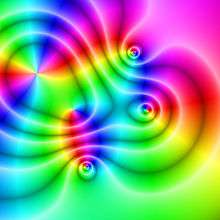Domain coloring

ƒ(x) =(x2 − 1)(x − 2 − i)2/(x2 + 2 + 2i). The hue represents the function argument, while the saturation and value represent the multiply-wrapped magnitude.
Domain coloring is a technique for visualizing functions of a complex variable. The term "domain coloring" was coined by Frank Farris, possibly around 1998.[1][2] There were many earlier uses of color to visualize complex functions, typically mapping argument (phase) to hue.[3] The technique of using continuous color to map points from domain to codomain or image plane was used in 1999 by George Abdo and Paul Godfrey[4] and colored grids were used in graphics by Doug Arnold that he dates to 1997.[5] A comprehensive introduction to phase plots (a special version of domain coloring) is given in Elias Wegert's textbook.[6]
Motivation
Insufficient dimensions
A real function (for example ) can be graphed using two Cartesian coordinates on a plane.
A graph of a complex function of one complex variable lives in a space with two complex dimensions. Since the complex plane itself is two-dimensional, a graph of a complex function is an object in four real dimensions. That makes complex functions difficult to visualize in a three-dimensional space. One way of depicting holomorphic functions is with a Riemann surface.
Visual encoding of complex numbers
Given a complex number , the phase (also known as argument) can be represented by a hue, and the modulus is represented by either intensity or variations in intensity. The arrangement of hues is arbitrary, but often it follows the color wheel. Sometimes the phase is represented by a specific gradient rather than hue.

Example
The following image depicts the sine function from to on the real axis and to on the imaginary axis.

See also
References
- ↑ Frank A. Farris, Visualizing complex-valued functions in the plane
- ↑ Hans Lundmark (2004). "Visualizing complex analytic functions using domain coloring". Retrieved 2006-05-25. Ludmark refers to Farris' coining the term "domain coloring" in this 2004 article.
- ↑ David A. Rabenhorst (1990). "A Color Gallery of Complex Functions". Pixel: the magazine of scientific visualization. Pixel Communications. 1 (4): 42 et seq.
- ↑ George Abdo & Paul Godfrey (1999). "Plotting functions of a complex variable: Table of Conformal Mappings Using Continuous Coloring". Retrieved 2008-05-17.
- ↑ Douglas N. Arnold (2008). "Graphics for complex analysis". Retrieved 2008-05-17.
- ↑ Elias Wegert (2012). Visual Complex Functions - An Introduction with Phase Portraits. Springer Basel. ISBN 9783034801799. Retrieved 6 January 2016.
External links
- Color Graphs of Complex Functions
- Visualizing complex-valued functions in the plane.
- Gallery of Complex Functions
- Complex Mapper by Alessandro Rosa
- John Davis software - S-Lang script for Domain Coloring
- Open source C and Python domain coloring software
- Enhanced 3D Domain coloring
- Domain Coloring Method on GPU
- Java domain coloring software (In development)
- MATLAB routines
- Python script for GIMP by Michael J. Gruber
- Matplotlib and MayaVi implementation of domain coloring by E. Petrisor
- MATLAB routines with user interface and various color schemes
- MATLAB routines for 3D-visualization of complex functions